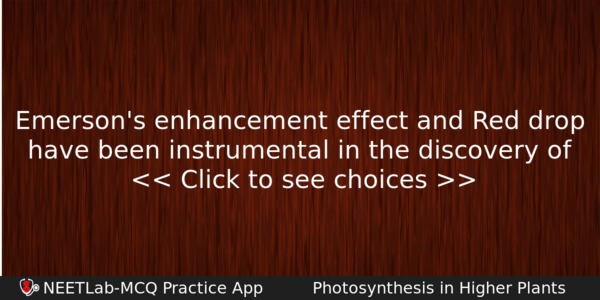| ⇦ | 
| ⇨ |
Emerson’s enhancement effect and Red drop have been instrumental in the discovery of
Options
(a) Photophosphorylation and non-cyclic electron transport
(b) Two photosystems operating simultaneously
(c) Photophosphorylation and cyclic electron transport
(d) Oxidative Phosphorylation
Correct Answer:
Two photosystems operating simultaneously
Explanation:
The Emerson effect is the increase in the rate of photosynthesis after chloroplasts are exposed to the light of wavelength 670 nm (red light) and 700 nm (far-red light). When simultaneously exposed to the light of both wavelengths, the rate of photosynthesis is far higher than the sum of the red light and far-red light photosynthesis rates ( known as enhancement effect ). This experiment led to the discovery of two photosystems. – PS II and PS I.
Related Questions: - The nucleus is seperated from surrounding cytoplasm by a nuclear membrane
- Photosynthetic bacteria have pigments in
- Devices for self-pollination are
- Breeding of crops with high levels of minerals, vitamins and proteins is called
- Known sequences of DNA that is used to find complementary DNA strands is
Topics: Photosynthesis in Higher Plants
(153)
Subject: Biology
(4253)
Important MCQs Based on Medical Entrance Examinations To Improve Your NEET Score
- The nucleus is seperated from surrounding cytoplasm by a nuclear membrane
- Photosynthetic bacteria have pigments in
- Devices for self-pollination are
- Breeding of crops with high levels of minerals, vitamins and proteins is called
- Known sequences of DNA that is used to find complementary DNA strands is
Topics: Photosynthesis in Higher Plants (153)
Subject: Biology (4253)
Important MCQs Based on Medical Entrance Examinations To Improve Your NEET Score
18000+ students are using NEETLab to improve their score. What about you?
Solve Previous Year MCQs, Mock Tests, Topicwise Practice Tests, Identify Weak Topics, Formula Flash cards and much more is available in NEETLab Android App to improve your NEET score.
Share this page with your friends

Leave a Reply